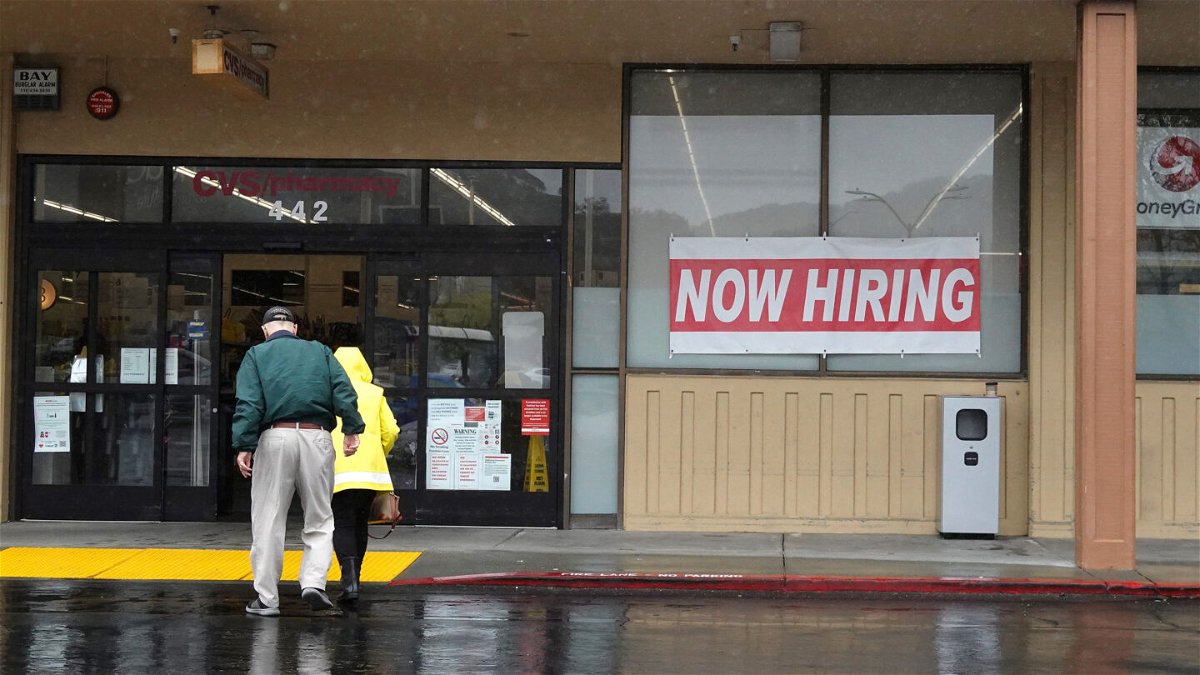Job openings tumble to lowest point in nearly two years

The number of open jobs in the United States has dropped to the lowest level since May 2021. People walk by a now hiring sign posted in front of a CVS store on April 07
By Alicia Wallace, CNN
The number of open jobs in the United States has dropped to the lowest level since May 2021, a reflection of a labor market that is slowly settling back into balance after the Federal Reserve’s yearlong campaign to cool off the economy.
Job openings totaled 9.59 million in March, according to monthly data released Tuesday by the Bureau of Labor Statistics. That’s down from an upwardly revised 9.974 million reported in February and represents the third consecutive month that available jobs have fallen.
Economists were expecting 9.775 million openings, according to consensus estimates on Refinitiv.
As of March, the ratio of open jobs to the number of unemployed Americans fell to 1.65, BLS data shows.
“Demand for labor is cooling, and the dynamics of the labor market are normalizing,” said Julia Pollak, chief economist at ZipRecruiter. “After two years of incredibly rapid churn and highly elevated demand, things are now all going back to normal levels and rates.”
Rising layoffs, no new hiring
The latest Job Openings and Labor Turnover Survey showed that layoffs jumped by nearly 250,000 to 1.8 million — the highest level since December 2020 — while the number of new hires were unchanged at 6.15 million and quits ticked down to 3.85 million from 3.98 million.
“More quits are a sign of worker confidence, and more layoffs and discharges are when employers are more cautious to hire and more likely to cut jobs,” said Erica Groshen, a former BLS head who now serves as the senior economics adviser at the Cornell University School of Industrial and Labor Relations.
“And those move in opposite directions when the labor market starts to weaken,” she said.
Some of the industries seeing the biggest cutback in open positions include those within transportation, warehousing and utilities; construction; and other services.
The largest jump in layoffs during March was seen in the construction industry. The Fed’s aggressive rate-hiking campaign has resulted in weakened demand within the housing sector; however, layoffs in construction have lagged, given a strong backlog in projects post-pandemic.
“I don’t want to overhype one month of data, but if you were looking for a place where the fallout from the aggressive tightening of monetary policy would start, it’d be in the construction industry,” said Nick Bunker, economic research director for North America at the Indeed Hiring Lab.
A cooldown that is ‘unambiguous’
In recent months, layoff announcements have been mounting, with most of the cutbacks coming from high-growth technology businesses that bulked up as Americans’ behaviors shifted during the pandemic. Companies in sectors such as finance, media, retail and manufacturing have also scaled back their workforces.
However, the broader labor market has remained relatively unfazed. The US economy added a net 1 million jobs during the first quarter.
That rate of growth — already far slower than the breakneck pace of job gains seen during much of the past two years — is expected to show continued moderation when the government releases the April jobs report this Friday.
Economists are expecting the economy to have added only 179,000 jobs during April and for the unemployment rate to climb to 3.6% from 3.5% in March, according to consensus estimates on Refinitiv.
JOLTS data is now pointing in a similar direction as other labor market data, Bunker said.
“The cooldown in the US labor market is unambiguous at this point,” he said.
The impact of the banking turmoil
The declines in openings and increases in layoffs were seen across the country’s four regions. Some of the biggest pullbacks in openings occurred at the small business level, or employers with fewer than 50 workers, Pollak said.
Historically, tightening credit conditions hit small businesses the hardest, she said.
“They are a big drag … they are preventing them from being able to get loans to invest in new equipment or new locations and in growing headcount,” she said. “And that drag is only likely to get worse in the coming months as regional banks stop lending to small businesses [in order] to shore up their capital and reduce their risk of a liquidity crisis.”
Tuesday’s JOLTS report is one of the last pieces of key economic data to be released before the Fed’s policymaking decision on Wednesday.
Economists and analysts expect that the Fed will raise its benchmark rate by another quarter point — marking the central bank’s 10th rate hike since March 2022. Economists also widely anticipate that the Fed will then pause to assess the effects of its own tightening cycle as well as any impacts from the recent upheaval within the banking industry.
The-CNN-Wire
™ & © 2023 Cable News Network, Inc., a Warner Bros. Discovery Company. All rights reserved.
